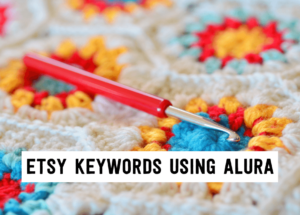
How to find the best Etsy keywords in 3 simple steps using Alura
If you want to be found in search results on Etsy, you need to optimize your product listing for SEO. And if you want to
join
join
Lots of handmade sellers are dipping their toes into POD, and you might be wondering:
“How do I price POD products?”
POD is a very specific type of product, and today we’re going to talk about how to price your POD products: what to include in the cost, and how to set up your markup to determine your final price.
And – in doing so – I will be answering the most frequently asked questions that I hear from the sellers that I work with, questions like:
What about platform fees?
What about the time spent designing?
What about shipping to customers . . . how do I include that in my price?
What about my advertising or marketing costs?
. . . We’ll talk about each of these a bit later in this article, so keep reading!
So, ready? Let’s dive in.
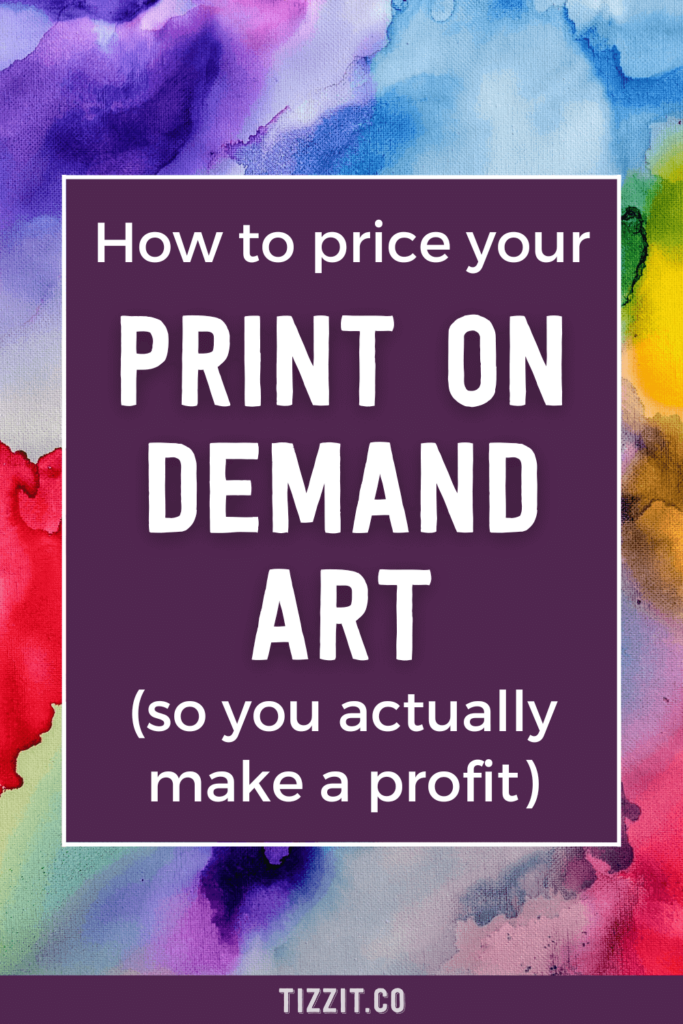
When you think about price, the very basic concept is cost plus markup.
The million-dollar question, though, is:
What is considered a cost?
What should you add – and not add -into your cost, especially when you’re pricing print on demand (POD) products, where things are a little bit different than if you’re selling products that you either make yourself (like handmade products), or digital goods, or manufactured products.
The cost of your product is made up of 1) your cost of goods sold (also known as COGS), 2) your labor, and 3) your overhead.
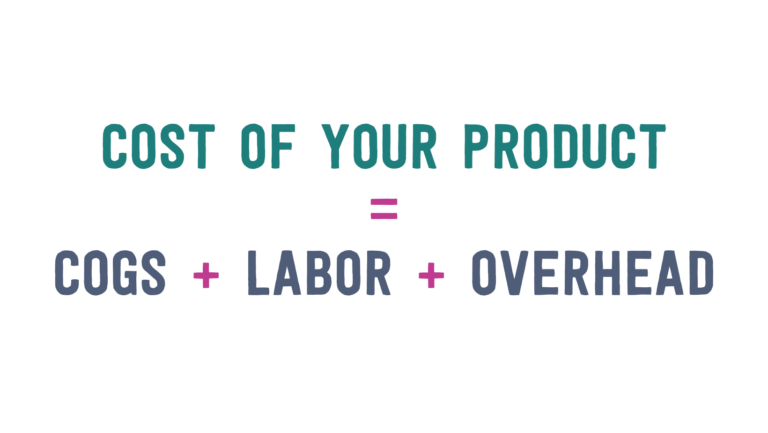
Let’s talk about each one of these in relation to POD products, starting with Cost Of Goods Sold.
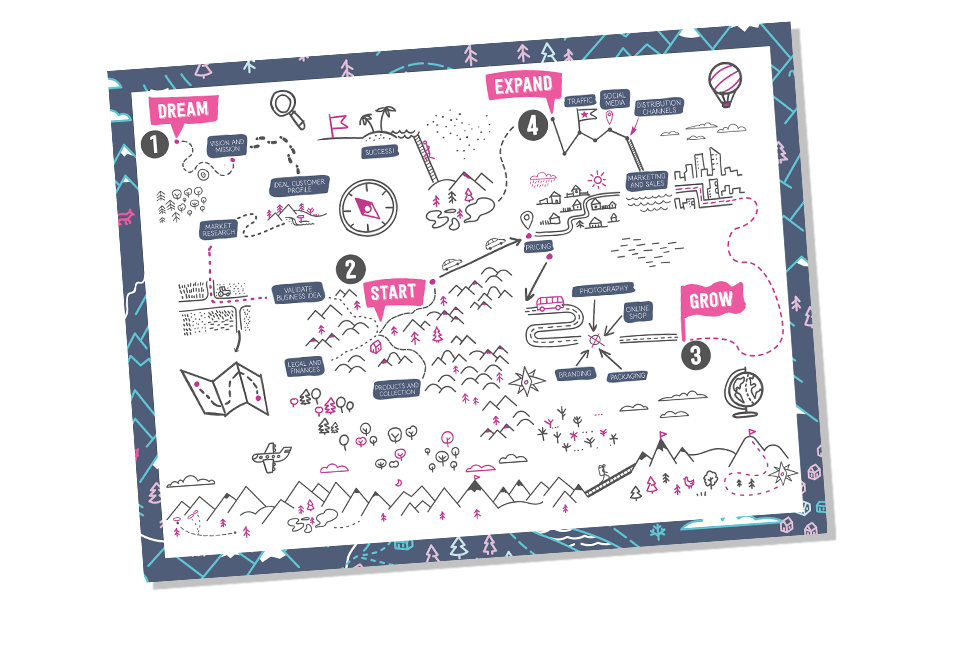
DOWNLOAD THE MAKERS ROADMAP!
I like to think of Cost of Goods Sold, or COGS, as your variable product creation costs – so essentially what each product sold has cost to create. It’s variable because the more products you sell, the more of this cost you’re going to have. If you don’t sell any products that month, you’re not going to have any COGS, if you sell 100 products you will have 100x the COGS for that product.
So what goes into your Cost Of Goods Sold?
Pretty much anything that’s related to the product creation . . . so the raw materials and supplies that are needed to create your products . . . and also your packaging costs.
Why packaging costs?
Because once the product is created, you need to put it in a box or envelope before you can send it in the mail, right? That packaging cost is also a part of the COGS because it’s a cost that you incur each time you make a sale.
Now today we’re talking about print on demand (POD), and in this case your COGS is actually all covered in the price that your POD provider is charging you for the sale of a product.
Let’s take a look at an example from Printify:
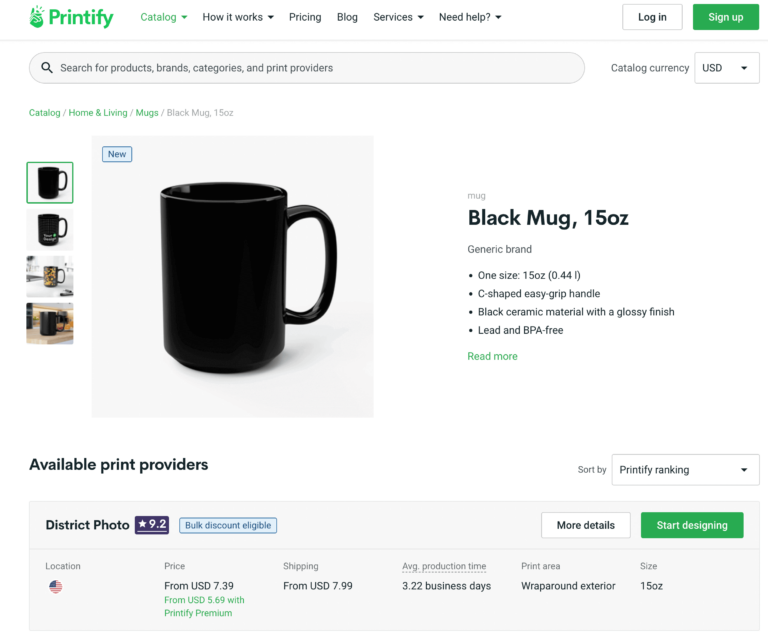
Here is a black mug that is going to cost $7.39 to be created and packaged — so very easy for you to determine COGS.
The next cost I want to talk about is labor.
Labor is the time that you spend creating each product.
Typically, that would be your time spent creating a product times your hourly wage.
But it can get a little confusing for POD – especially when you come from the handmade world and you start selling POD rather than physical products.
With POD, you are not actually spending any time creating those products, because your POD provider does that for you.
Now I can already hear you saying “but Deb, I DO spend time designing the design that’s being printed on those products! Doesn’t that go into labor cost?” And you are right, you do spend time designing or painting or coming up with the idea for the product, but you should not include that cost in your labor cost. You will account for it somewhere else, so keep reading as we’ll talk more about this later in the article.
The final part of your costs is your overhead or fixed costs.
These are the costs that you have to pay to run your business even when you don’t make a single sale – that’s why we call them fixed, they don’t change. And whether you make 1000 sales that month, or 10 sales that month, they’re typically the same.
Examples of overhead costs would include your studio rent, insurance, monthly website fees, any monthly subscription fees for software that you use to design your products, office supplies… basically anything that you need to pay every month to run your business no matter how many sales you make.
You want to make sure you list everything out – don’t skip anything – because it does add up. You may have things where you think “I don’t need to include that in my overhead” – like paying the internet, for example – but that is a fee if you need to use the internet to work, and so you need to add things like that into your overhead.
Now that we know how much it costs to create your product, let’s move on and talk about how you determine the final price by adding profit – or markup – into this equation.
There are two main ways to determine your markup: value-based and market-based.
Both of them are relevant because you have to look at what the competition is offering and at what price AND you also have to look at what the market can bear.
For example, if you start selling your products at a price two or three times more expensive than your competitors, you need to have a really good reason for that – your products need to be unique enough to justify that higher price.
So for the majority of print on demand sellers, the market is going to dictate how much you can charge, but that doesn’t mean that there is no room for value-based pricing.
Value-based pricing is based on the perceived value of the product – how much this product is worth in the eye of the customer.
So it’s not the cost of the actual product, like the mug or the cotton t-shirt. It’s the perceived value of the design on that product and what it means to them to be wearing or using a product with that design on it.
You may have a design that is unique and hard to replicate, or you may have a decent brand following. Both these things would impact perceived value.
Let’s say you’re an illustrator, and you have a great following for making funny illustrations on Instagram. When you decide to open your POD store to put some of your designs on products that you want to sell, you’re likely to be able to charge a bit more than other people in your niche because you already have people that want what you create – your unique illustrations. And so that’s something that you can charge more for because no one else can sell your exact design or illustrations on a product. Value-based pricing will be most useful here and you can pretty much price as high as you think your followers are willing to pay.
On the flip side, let’s say you’re selling t-shirts with cute quotes on them, something like “don’t talk to me until I’ve had my coffee.” Even though you can choose a cute font and arrange the words in a way unique to your t-shirt, there’s a lot of competition out there in the shirt market and it’s easy for someone else to put that on a t-shirt and compete with you… so you are going to have to stick close to the market price – the price your competitors are selling for – if you want to have product sales. So in this case you would be using a market-based approach to determine your markup.
You can see based on these two examples that if you want to start selling POD products for a price that is two or three times more than your competitors, you need to have a really good reason for that — your products need to be unique enough to justify that higher price.
If your products are going to be in close competition with similar products, then you will rely heavily on a market-based analysis to decide your markup.
Of course you will always use a bit of both, but the more brand awareness and the bigger the fanbase, the more you can charge.
Now that we’ve covered the basics of POD pricing, I’m going to answer the most frequent questions that I hear to help you understand the trickier parts of pricing.
Let’s start with platform fees.
You may be wondering where to include things like your Shopify fees, your Etsy fees, or even your Printful fee (or whatever POD website you’re using).
And the first thing I will tell you is to go back to the fixed or variable question.
If it’s a fixed cost – so it’s a subscription that you pay every month – that’s essentially an overhead cost and something that needs to go into overhead.
If not – if you have marketplace fees for places like Etsy, for example, or transaction or merchant fees, then you need to handle them differently:
Most sellers try to adjust the price to cover the percentage fee that they are charged by the platform, Paypal, or something else like that. It makes sense in a way but it definitely does not work. Let me explain.
If you add a percentage fee (like for example Etsy transaction fees if you sell on Etsy but this is true for any platform percentage-based fee) to your price, but the fee is calculated from the price, once you add the fee—guess what? The fee goes up because you increased the price to cover the fee . . . and this loop will go on and on forever.
For example, you have an item that you want to price at $50, that’s how much you want to get after the fee is taken out. If you have to pay a fee of 5% of that $50, the fee will be $2.50.
And if you want to include that $2.50 that into your price to cover the fee, then you need to list the item at $52.50. But if you do, the new fee is not going to be $2.50, like you just calculated. It’s going to be 5% of $52.50!
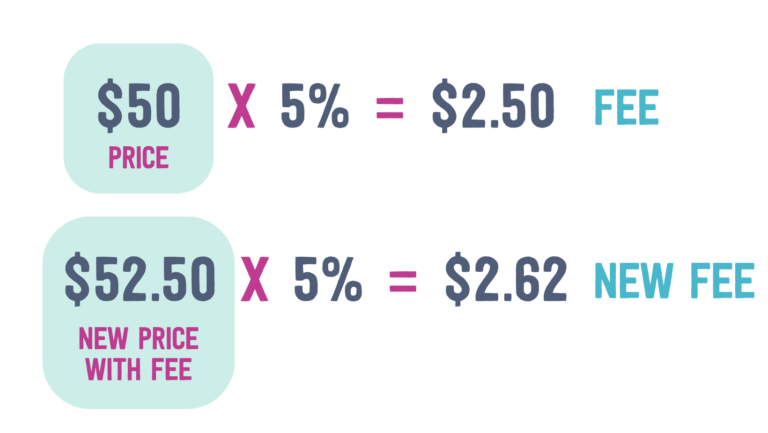
And so it’s going to constantly go up, right? You’re going to be stuck in an ever-increasing loop, and mathematically complicated.
In accounting terms the way to deal with those fees is to treat them as a selling or business expense because that’s what they are.
They are not a product cost, so they should not go into your cost of goods sold.
So for the purpose of coming up with your prices you can either estimate what these would be for a year and add that amount to your overhead rate, or, if you have data from your previous year or previous years in business, then of course use that amount instead.
Another question I frequently hear is “What about the time that I spend designing my product?”
So earlier when we talked about labor, I mentioned that labor for POD products is … pretty much non-existent.
With POD products, each time someone orders a new product from you and you make a sale, you don’t spend time creating that product at all right? And then you also don’t spend time packaging and go to the post office to ship it. Your POD service does that for you. That’s the magic of it.
So although you could think of it as labor, because you did spend time creating the original design that’s going to be printed on several (hopefully MANY!) products, please don’t add that into your labor because you risk pushing your price way up when you don’t need to.
Let’s look at a quick example to show how adding this cost into labor can cause problems and over-inflate your prices:
Let’s say you design a cool-looking t-shirt with a cute phrase and a graphic. You think “Ok it took me 5 hours to design this, I think my hourly rate is $40, so that’s $200. I am going to assume I’ll sell at least 50 of this t-shirt so that’s $4 per product in labor cost I can add to my cost calculations.
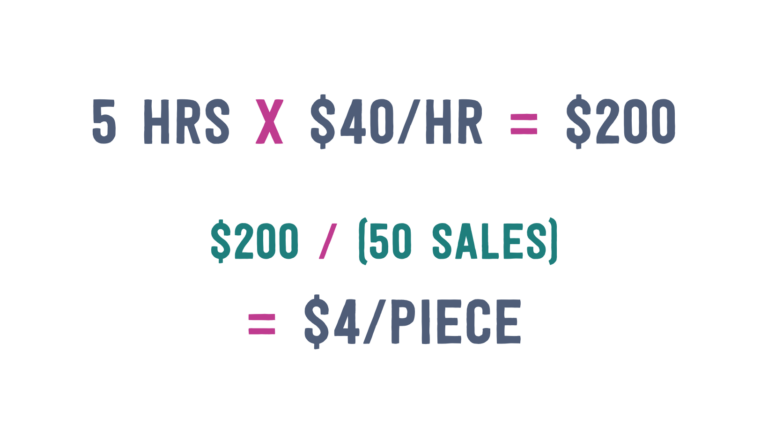
I don’t like this logic, because you don’t know how many you will sell. It’s a bit of a random guess unless you’ve been at this for a while and can predict very accurately how many sales of each product you’ll make. Or unless it’s a limited edition print. For most of you, some designs are going to kill it, others will flop.
In our example, once you sell past that number – say you sell over 50 t-shirts – you’re charging $4 per product even though you’re not actually spending any time on the design each time you sell… it’s something you only did once.
This will push your price WAYYY up when it doesn’t need to because you only did this once and can now scale (the magic of POD) your sales without investing more time into that product design each time a sale is made.
Another similar question I get is “What about the time that I spend creating a listing, creating images for it, writing a description, adding the product for sale on Shopify or Etsy or Printify or the like, and then doing keyword research — all of that stuff?”
The answer to this is similar to what we’ve just been talking about: you can’t include that in your labor calculation because it will skyrocket your price and inflate it to a point where it won’t be competitive enough for you to be selling.
Plus, it just doesn’t make sense to include it because you’re not doing that each time a product is sold.
So again, remember that when we look at the cost + markup = price equation, our cost in this equation is the cost of goods sold and the labor related to the creation of the product each time one is sold.
And since these things are not something that you do each time it’s sold, nor related to the creation of the actual product being sold, you don’t include them.
So what do you do? You cover these types of costs with your profit. What I mean by that is, at the end of each month when you add up all the sales across all products, your PROFIT needs to be healthy enough that you can “afford” to spend time designing your products and putting them up for sale online.
You may also be wondering, what about shipping to customers? (That’s pretty much the ultimate question!)
You basically have two options here: you’re either going to pass that cost on to your customers, or you’re going to offer free shipping to your customers (which is never really free shipping, it just means that it’s included in the final retail price that you’re communicating on your website).
If you pass the shipping cost on to the customers, they see the product price on the product page. Once they go to checkout, the shipping profile from your POD provider will add the shipping price to that product price and give the customer a total amount due for the purchase..
The shipping price will be based on where it’s shipping from (where your print partner for that product is located) and to (where your customers live) and how quickly they need the product shipped.
The other option you can consider is offering free shipping.
Now just so we’re clear, you’re still “charging” for shipping. The wording is misleading. You, as the business, never pay for shipping, ok? Think of “free shipping” as “shipping included in displayed price” – that’s actually what ”free shipping” is (and would honestly be a much more ethical and honest way to call it because free shipping is never free but that’s a rant for another day!).
When you offer free shipping, you will add the shipping cost to your price and communicate this new price as your retail price with free shipping. So you will take your cost + markup to determine your price without shipping, then add your shipping cost to that and TADA! You have a sales price that includes free shipping.
We know that people are more likely to buy when there’s no unexpected surprise at checkout of a price they didn’t see coming – so for example they had $10 in mind when they added the product to the cart, and suddenly it’s $15 with the shipping.
Before deciding on which shipping option you want to offer, it’s important to see what your competition is doing. If everyone is including it in their price, you should strongly consider including it in yours.
And if you are selling on platforms like Etsy, then I definitely recommend offering free shipping when possible because it also has an impact on SEO and your ranking, making it even more important to include it so you can be competitive.
Side note: Most print on demand websites give you a choice of POD manufacturers in different locations. Here’s an example:
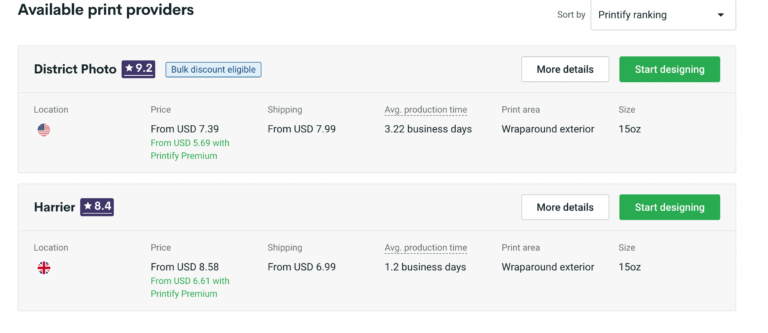
Be sure to choose this POD manufacturer carefully and consider their location – if most of your customers are in the UK, for example, pick a POD manufacturer that is located in the UK, so that your cheapest shipping costs are to the location of the majority of your customers.
The basic answer is, you add the cost of shipping to the product’s final retail price. But it gets a bit more complicated if you ship to different countries.
Let’s go back to our mug example. If I live in the United States and I want to offer free shipping to the entire world, I have to include the highest shipping amount I could be charged in the price – so if you look at this chart, it would be the shipping cost for a customer in Canada.
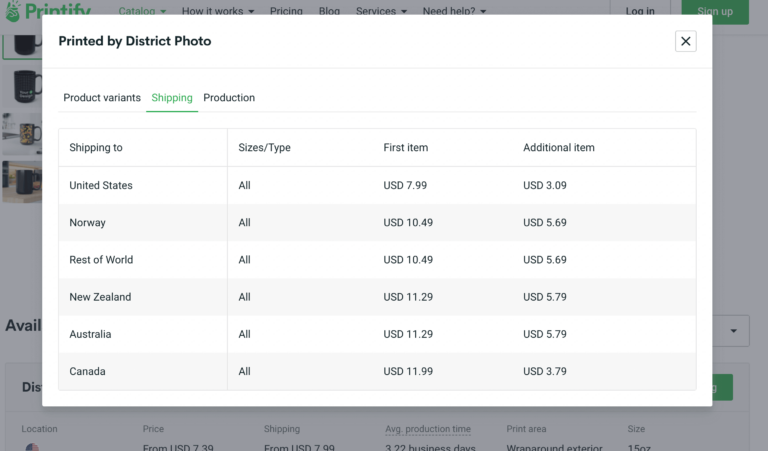
And so I’d need to include that $11.99 to my final retail price to be able to offer free shipping worldwide, or I will have to pay that extra shipping money out of pocket. Meaning, if I had only added $7.99 to my price and someone ordered a product for shipping to Canada, I end up paying the $4 difference between $7.99 and $11.99 out of my own pocket, right? That’s not what I want to do.
So to offer worldwide free shipping, you’d need to add the highest one into your price – the $11.99 so all areas are covered. In this example, you could also decide to offer free shipping only to the US and add $7.99 to your price.
Now – if your customers are mostly located in the UK, you’re better off picking a print partner located in the UK or close by so you can offer a more competitive price with free shipping.
For this exact same mug, if you change provider to a UK-based one, including shipping, your price suddenly is down to $5.49 for “free” shipping to the UK.
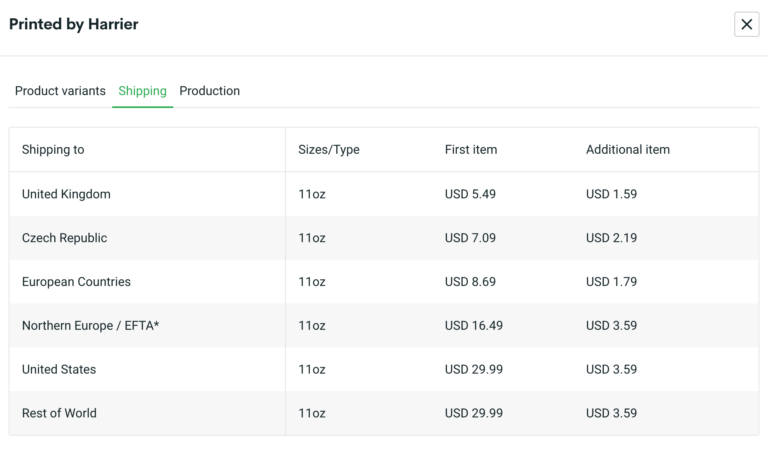
The reason I spend some time showing you this is because a lot of sellers pick a provider next to where they reside. It’s normal to feel this way – but in reality, you are MUCH better off picking a provider in an area where there is enough demand but less competition so you can offer competitive pricing.
You may also be wondering if you need to incorporate advertising fees in your product cost.
These are things like Etsy offsite ads or your promoted listing fees.
Even though they’re called fees, they are essentially a marketing expense – they don’t have anything to do with the cost of making your product.
It’s the same as if you were to advertise on Facebook, Google, Pinterest, or Instagram — that’s part of your marketing budget.
So how can you account for it in your prices?
I know some sellers will try to average out what their advertising costs would be for a year and add that to their overhead; so for example they’ll say to make THIS amount in sales this year I am estimating I’ll spend THAT amount on ads and then use that in their overhead.
It can work, but I’ve said this before and it’s well worth repeating here… I find this approach has a few limitations:
First, it’s really hard to estimate your ads’ costs as these vary over the year. If you plan to spend a fixed amount on ads every month, say “every month I plan to spend $200” on ads then sure that works.
But in reality, ad costs can go up and down by quite a bit over a year (even over a month!), and they also tend to go up during busy shopping periods where most of your sales might come from… so you might spend more than what you estimated.
Second, if you account for those costs in your overhead – you can also quickly over-inflate your prices, because to set your prices, you end up multiplying your costs by your profit markup, and it can go up really fast, pricing you out of the market.
So what can you or should you do?
I do think a more proper way to account for them is when setting your profit margin. It needs to be ample enough to allow you to re-invest in your business, and that includes things like advertising. Profit is not meant to be all take-home. Your gross profit SHOULD cover things like advertising.
This way you work with money you already have (your existing profit, cash in the bank) and a clear budget to work with each month, and you can then monitor your paid campaigns closely to make sure that for each product you sold, you are not spending more than the profit margin of that product allows you to spend.
Congratulations!! You now are ready to price your POD products to make them competitive AND to generate a healthy profit for your handmade shop!
If you’d like even more POD advice you will want to read this article about getting started with print on demand.
Thanks for reading and until next time, aurevoir!
you might also like…
related articles

If you want to be found in search results on Etsy, you need to optimize your product listing for SEO. And if you want to
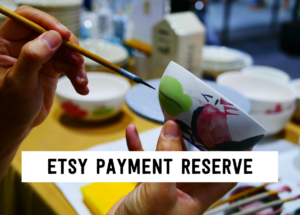
There has been a lot of talk in the Etsy community — and I mean A LOT of talk — about Etsy’s payment account reserve
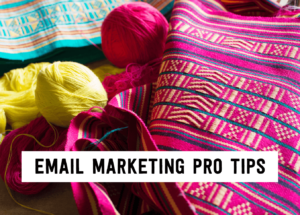
Anyone who knows me knows that I am a HUGE advocate for using email marketing to grow and scale your handmade business. But you may
disclaimer
subscribe to youtube
THE LAUNCHPAD
get in touch
We acknowledge and give thanks to the Budawang and Yuin people, the Traditional Owners of the land we work and live on. We pay our respects to all Aboriginal and Torres Strait Islander Peoples and elders past, present and emerging.
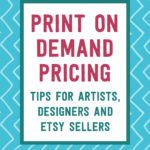
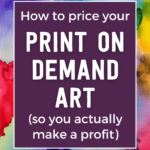

Get Instant Access to
The Makers Roadmap